Viverridae
| Viverridae Ma Eocene to Recent[1]
| |
|---|---|

| |
| Viverrids, including (top left to bottom right), species of Paguma and Arctictis
| |
| Scientific classification | |
| Domain: | Eukaryota |
| Kingdom: | Animalia |
| Phylum: | Chordata |
| Class: | Mammalia |
| Order: | Carnivora |
| Suborder: | Feliformia |
| Infraorder: | Aeluroidea |
| Parvorder: | Viverroidea |
| Family: | Viverridae Gray, 1821 |
| Type genus | |
| Viverra Linnaeus, 1758
| |
| Genera | |
| |

| |
| Distribution of living viverrid species | |
Viverridae is a
Almost all viverrids outside the subfamily Genettinae are commonly called civets, but some civets are not viverrids. Animals of the subfamily Genettinae are known as genets and oyans. The word viverridae comes from the Latin viverra 'ferret', but ferrets are in a different family, the Mustelidae.
Characteristics

Viverrids have four or five toes on each foot and half-retractile
Viverrids are the most primitive of all the families of
Their flesh-shearing carnassial teeth are relatively undeveloped compared to those of other feliform carnivorans.[5] Most viverrid species have a penis bone (a baculum).[6]
Classification
Living species
In 1821, Gray defined this family as consisting of the genera
In 1833, Edward Turner Bennett described the Malagasy fossa (Cryptoprocta ferox) and subordinated the Cryptoprocta to the Viverridae.[7] A molecular and morphological analysis based on DNA/DNA hybridization experiments suggests that Cryptoprocta does not belong within Viverridae, but is a member of the Eupleridae.[8]
The
| Subfamily | Genus | Species | Image of type species |
|---|---|---|---|
| Viverrinae | Viverra Linnaeus, 1758[11] |
|

|
| Viverricula Hodgson, 1838[14] | Small Indian civet (V. indica) (Geoffroy Saint-Hilaire, 1803)[15] | 
| |
| Civettictis Pocock, 1915[16] | African civet (C. civetta) (Schreber, 1776)[17] | 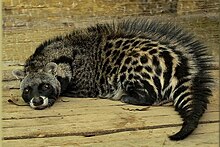
| |
| Hemigalinae Gray, 1864[18] | |||
| Hemigalus Jourdan, 1837[19] | Banded palm civet (H. derbyanus) Jourdan, 1837[19] | 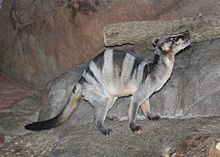
| |
| Cynogale Gray, 1836[20] | Otter civet (C. bennettii) Gray, 1836[20] | 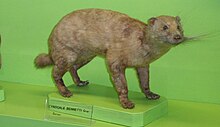
| |
| Diplogale Thomas, 1912[21] | Hose's palm civet (D. hosei) (Thomas, 1892)[22] | 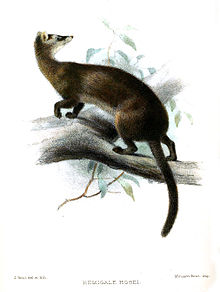
| |
| Macrogalidia Schwarz, 1910[23] | Sulawesi palm civet (M. musschenbroekii) (Schlegel, 1877)[24] | 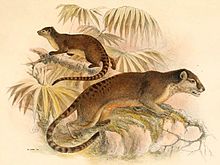
| |
| Chrotogale Thomas, 1912[21] | Owston's palm civet (C. owstoni) Thomas, 1912[21] | 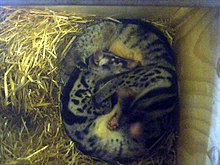
| |
| Paradoxurinae Gray, 1864[18] | Paradoxurus Cuvier, 1822[25] |
|
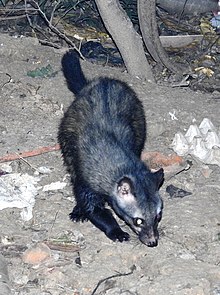
|
| Arctictis Temminck, 1824[29] | Raffles, 1822)[30]
|
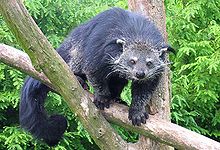
| |
| Paguma Gray, 1831[31] | Masked palm civet (P. larvata) (Smith, 1827)[32] | 
| |
| Arctogalidia Merriam, 1897[33] | Small-toothed palm civet (A. trivirgata) (Gray, 1832)[34] | 
| |
| Genettinae | Genetta Cuvier, 1816[35] |
|

|
| Poiana Gray, 1864[18] |
|

|
Phylogeny
The phylogenetic relationships of Viverridae are shown in the following cladogram:[1][10]
| Viverridae |
| ||||||||||||||||||||||||||||||||||||||||||||||||||||||||||||||||||||||||||||||||||||||||||||||||||||||||||||||||||||||||||||||||||||||||||||||||||||||||||||||||||||||||||||||
Extinct species
| Subfamily | Genus | Species |
|---|---|---|
| Viverrinae | Viverra Linnaeus, 1758 | Leakey's civet (V. leakeyi) Leakey, 1982 |
| Semigenetta Helbing 1927 |
| |
| Paradoxurinae | Kichechia Savage, 1965[50] | |
| Tugenictis Morales & Pickford, 2005[52][53] | †T. ngororaensis[52] Morales & Pickford, 2005 | |
| Kanuites Dehghani & Werdelin, 2008[54] | †K. lewisae[54] Dehghani & Werdelin, 2008 | |
| Siamictis Grohé et al., 2020[55] | †S. carbonensis[55] Grohé et al., 2020 |
See also
References
- ^
- ^ OCLC 62265494.
- ^ a b c Gray, J. E. (1821). "On the natural arrangement of vertebrose animals". London Medical Repository. 15 (1): 296–310.
- ^ a b c Pocock, R. I. (1939). "Family Viverridae". The Fauna of British India, including Ceylon and Burma. Vol. Mammalia. – Volume 1. London: Taylor and Francis. pp. 330–332.
- ISBN 0-87196-871-1.
- ISBN 0-8014-8493-6.
- ^ Bennett, E. T. (1833). "Notice of a new genus of Viverridous Mammalia from Madagascar". Proceedings of the Zoological Society of London. 1833: 46.
- S2CID 21555307.
- PMID 14667345.
- ^ PMID 22369503.
- ^ a b Linnaeus, C. (1758). "Viverra". Systema naturæ per regna tria naturæ, secundum classes, ordines, genera, species, cum characteribus, differentiis, synonymis, locis 1 (Tenth ed.). Stockholm: Laurentius Salvius. pp. 43–45.
- ^ Gray, J. E. (1832). "On the family of Viverridae and its generic sub-divisions, with an enumeration of the species of several new ones". Proceedings of the Committee of Science and Correspondence of the Zoological Society of London. 2: 63–68.
- ^ a b Blyth, E. (1862). "Report of Curator, Zoological Department, February 1862". The Journal of the Asiatic Society of Bengal. 31 (3): 331–345.
- ^ Hodgson, B. H. (1838). "Classified Catalogue of Nepalese Mammalia". Annals of Natural History. 1 (2): 152−154.
- ^ Geoffroy Saint-Hilaire, E. (1803). "La Civette de l'Inde". Catalogue des Mammifères du Museum National d'Histoire Naturelle. Paris: Museum National d'Histoire Naturelle. p. 113.
- .
- ^ Schreber, J. C. D. (1778). "Die Civette Viverra civetta". Die Säugethiere in Abbildungen nach der Natur, mit Beschreibungen. Erlangen: Wolfgang Walther. pp. 418–420.
- ^ a b c Gray, J. E. (1864). "A revision of the genera and species of viverrine animals (Viverridae), founded on the collection in the British Museum". Proceedings of the Zoological Society of London for the Year 1864: 502–579.
- ^ a b Jourdan, C. (1837). "Mémoire sur deux mammifères nouveaux de l'Inde, considérés comme types des deux genres voisins des Paradoxures, genres Hémigale et Ambliodon". Comptes rendus hebdomadaires des séances de l'Académie des sciences: 442–447.
- ^ a b Gray, J.E. (1836). "Characters of some new species of Mammalia in the Society's collection". Proceedings of the Zoological Society of London. Part IV (October): 87–88.
- ^ a b c Thomas, O. (1912). "Two new Genera and a Species of Viverrine Carnivora". Proceedings of the Zoological Society of London. Part II: 498–503.
- ^ Thomas, O. (1892). "On some Mammals form Mount Dulit, North Borneo". Proceedings of the Zoological Society of London. Part I: 221–226.
- ^ Schwarz, E. (1910). "Notes on some Palm-Civets". The Annals and Magazine of Natural History; Zoology, Botany, and Geology. 8. 5 (29): 422–424.
- ^ Schlegel, H. (1879). "Paradoxurus musschenbroekii". Notes from the Royal Zoological Museum of the Netherlands at Leyden. 1 (Note XIV): 43.
- ^ Cuvier, F. (1822). "Du genre Paradoxure et de deux espèces nouvelles qui s'y rapportent". Mémoires du Muséum d'Histoire Naturelle Paris. 9: 41–48.
- ^ Pallas, P. S. (1778). "Das Zwitterstinkthier". In Schreber, J. C. D. (ed.). Die Säugethiere in Abbildungen nach der Natur, mit Beschreibungen. Erlangen: Wolfgang Walther. p. 426.
- ^ Pallas, P. S. (1778). "Der Boshond". In Schreber, J. C. D. (ed.). Die Säugethiere in Abbildungen nach der Natur, mit Beschreibungen. Erlangen: Wolfgang Walther. p. 451.
- .
- ^ Temminck, C. J. (1824). "XVII Genre Arctictis". Monographies de mammalogie. Paris: Dufour & d'Ocagne. p. xxi.
- ^ Raffles, T. S. (1822). "XVII. Descriptive Catalogue of a Zoological Collection, made on account of the Honourable East India Company, in the Island of Sumatra and its Vicinity, under the Direction of Sir Thomas Stamford Raffles, Lieutenant-Governor of Fort Marlborough', with additional Notices illustrative of the Natural History of those Countries". The Transactions of the Linnean Society of London. XIII: 239–274.
- ^ Gray, J. E. (1831). "Paguma". Proceedings of the Committee of Science and Correspondence of the Zoological Society of London. Vol. 1. London: Zoological Society of London. p. 95.
- ^ Smith, C.H. (1827). "Gulo larvatus, the Masked Glutton". In Griffith, E. (ed.). The animal kingdom : arranged in conformity with its organization. Vol. 2. Mammalia. London: G.B. Whittaker. p. 281.
- S2CID 5336742.
- ^ Gray, J.E. (1832). "On the Family of Viverridae and its generic subdivisions; with an enumeration of the Species of Paradoxurus, and Characters of several new ones". Proceedings of the Committee of Science and Correspondence of the Zoological Society of London (Part 2): 63–68.
- ^ Cuvier, F. (1816). Cuvier, G. (ed.). Le règne animal distribué d'après son organisation, pour servir de base à l'histoire naturelle des animaux et d'introduction à l'anatomie comparée. Vol. I. Paris: Deterville.
- ^ Linnaeus, C. (1758). "Viverra genetta". Systema naturæ per regna tria naturæ, secundum classes, ordines, genera, species, cum characteribus, differentiis, synonymis, locis 1 (Tenth ed.). Stockholm: Laurentius Salvius. p. 45.
- ^ Schreber, J. C. D. (1778). "Die Bisamkaze Viverra tigrina". Die Säugethiere in Abbildungen nach der Natur mit Beschreibungen. Vol. Dritter Theil. Erlangen: Walther. pp. 425–426.
- ^ Thunberg, C. P. (1811). "Beskrifning och teckning pa Viverra felina". Kungliga Swenska Wetenskaps Academiens Handlingar: 165–168.[permanent dead link]
- ^ Gray, J. E. (1828). "Viverra maculata". Spicilegia zoologica : original figures and short systematic descriptions of new and unfigured animals. London: Treuttel, Wurtz & Co. p. 9.
- ^ Geoffroy Saint-Hilaire, I. (1832). "Descriptions d'une nouvelle espèce du genre Genette. Genetta. Cuv.". Études Zoologiques : Ouvrage comprenant l'histoire et la description d'un grand nombre d'animaux récemment découverts et des observations nouvelles sur plusieurs genres déjà connus. Paris: Lequien Fils. p. 73.
- ^ Rüppell, E. (1835). "Viverra abyssinica. Rüppell". Neue Wirbelthiere zu der Fauna von Abyssinien gehörig. Frankfurt: Siegmund Schmerber.
- ^ Waterhouse, G. R. (1838). "On some New Species of Mammalia from Fernando Po". Proceedings of the Zoological Society of London: 57–61.
- .
- ^ Matschie, P. (1902). "Über die individuellen und geographischen Abänderungen der Ginsterkatzen". Verhandlungen des V. Internationalen Zoologen-Congresses zu Berlin, 12.–16. August 1901. Jena: Gustav Fischer. pp. 1128–1145.
- .
- JSTOR 1373716.
- S2CID 84351854.
- .
- .
- ^ a b Savage, R. J. G. (1965). "Fossil mammals of Africa: 19, The Miocene Carnivora of East Africa". Bulletin of the British Museum (Natural History). 10 (8): 239–316.
- doi:10.26879/778.
- ^ .
- S2CID 146620949.
- ^ .
- ^ S2CID 219296152.
External links
- "Genet: Wildlife summary". African Wildlife Foundation.
- "Viverridae". AnimalDiversity.org. University of Michigan.
- "Viverridae". ITIS.gov. Integrated Taxonomic Information System.
- Adams, Cecil (May 25, 2001). "Does civet come from tortured cats? Does kopi luwak coffee come from pre-eaten beans?". StraightDope.com.
